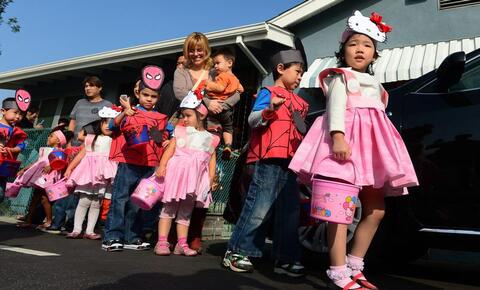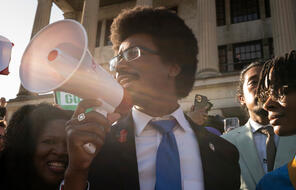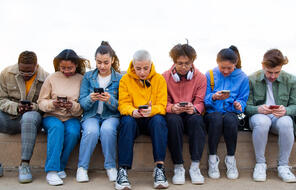Gender and Identity
At a Glance
Subject
- Advisory
- English & Language Arts
- History
- Social Studies
- Human & Civil Rights
- The Holocaust
Sometimes our assumptions and expectations about others prevent us from seeing who they really are as individuals. Some of the most powerful expectations about people that we learn from our culture are about gender. A person’s sex often leads us to make assumptions about that person’s identity. Martha Minow, a legal scholar, explains:
Of course, there are “real differences” in the world; each person differs in countless ways from each other person. But when we simplify and sort, we focus on some traits rather than others, and we assign consequences to the presence and absence of the traits we make significant. We ask, “What’s the new baby?”—and we expect as an answer, boy or girl. That answer, for most of history, has spelled consequences for the roles and opportunities available to that individual. 1
American author Lori Duron and her husband, Matt, have two children, both boys. She writes about what happened the first time her younger son, C.J., got a Barbie doll:
Schoolchildren dressed in Halloween costumes, Spiderman for boys and Hello Kitty for girls.
For days after C.J. discovered her, Barbie never left his side. When I'd do a final bed check at night before I retired for the evening to watch reality television and sneak chocolate when no one was looking, I'd see his full head of auburn hair sticking out above his covers. Next to him there would be a tiny tuft of blonde hair sticking out as well.
The next time we were at Target near the toy aisle—which I've always tried to pass at warp speed so the kids don't notice and beg me to buy them something—C.J. wanted to see “Barbie stuff.” I led him to the appropriate aisle and he stood there transfixed, not touching a thing, just taking it all in. He was so overwhelmed that he didn't ask to buy a single thing. He finally walked away from the aisle speechless, as if he had just seen something so magical and majestic that he needed time to process it.
He had, that day, discovered the pink aisles of the toy department. We had never been down those aisles; we had only frequented the blue aisles, when we ventured down the toy aisles at all. As far as C.J. was concerned, I had been hiding half the world from him.
I felt bad about that, like I had deprived him because of my assumptions and expectations that he was a boy and boys liked boy things. Matt and I noticed that C.J. didn't really like any of the toys we provided for him, which were all handed down from his brother. We noticed that C.J. didn't go through the normal boy toy addictions that Chase [C.J.'s older brother] had gone through: he couldn't care less about balls, cars, dinosaurs, superheroes, The Wiggles, Bob the Builder, or Thomas the Tank Engine. What did he like to play with? We didn't worry ourselves much about finding the answer (a case of the second-born child not getting fussed over quite like the first-born); we trusted that in time something would draw him in. Which it did. It just wasn't at all what we were expecting.
At about the eighteen- to twenty-four-month mark of a child's life, the gender-neutral toys disappear and toys that are marketed specifically to boys or to girls take over. We didn't realize it until later, but that divide in the toy world and our house being filled with only boy toys left C.J. a little lost at playtime. We and the rest of society had been pushing masculine stuff on him and enforcing traditional gender norms, when all he wanted was to brush long blonde hair and dress, undress, and re-dress Barbie. . . 2
Reflecting on C.J.’s identity, Duron concludes:
On the gender-variation spectrum of super-macho-masculine on the left all the way to super-girly-feminine on the right, C.J. slides fluidly in the middle; he's neither all pink nor all blue. He's a muddled mess or a rainbow creation, depending on how you look at it. Matt and I have decided to see the rainbow, not the muddle. But we didn't always see it that way.
Initially, the sight of our son playing with girl toys or wearing girl clothes made our chests tighten, forged a lump in our throats, and, at times, made us want to hide him. There was anger, anxiety, and fear. We've evolved as parents as our younger son has evolved into a fascinating, vibrant person who is creative with gender. Sometimes, when I think of how we behaved as parents . . . I'm ashamed and embarrassed. 3
- 1Martha Minow, Making All the Difference: Inclusion, Exclusion, and American Law (Ithaca, NY: Cornell University Press, 1990), 3.
- 2Lori Duron, Raising My Rainbow: Adventures in Raising a Fabulous, Gender Creative Son (New York: Broadway Books, 2013), 9–10. Reproduced by permission of Penguin Random House.
- 3Lori Duron, Raising My Rainbow: Adventures in Raising a Fabulous, Gender Creative Son (New York: Broadway Books, 2013), 4. Reproduced by permission of Penguin Random House.

Connection Questions
- What are the differences between the toys in the pink aisle and the toys in the blue aisle? What assumptions do the toys in those aisles reflect about what it means to be a boy or a girl?
- How do you explain the anxiety, anger, and fear Duron felt when C.J. started playing with “girl toys”? How did her feelings change?
- What are some other stereotypes about gender in your world? How do you respond to the assumptions people make about you because of your gender? To what extent do you accept or reject those assumptions?
How to Cite This Reading
Facing History & Ourselves, "Gender and Identity," last updated August 2, 2016.
This reading contains text not authored by Facing History & Ourselves. See footnotes for source information.













